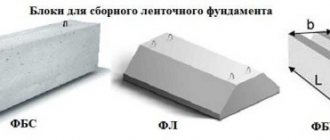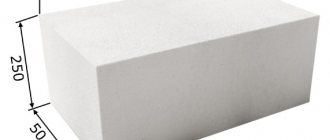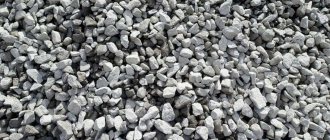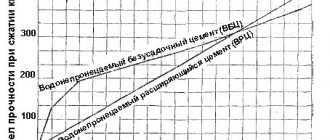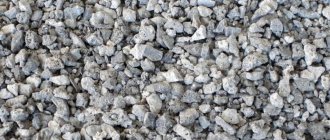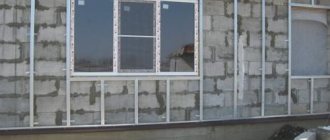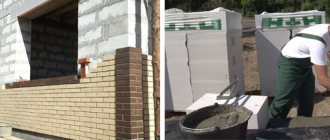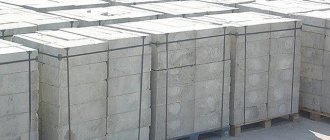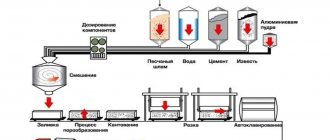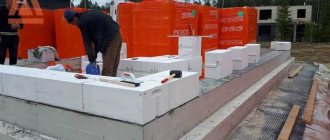Customer:
— There were many options. My wife, Nadezhda and I were thinking about how to do it faster. We explored options made from brick, cinder block and other types of materials. But since it requires a lot of physical effort, the “solution” needs to be mixed, it’s all boring... And since we are already aged, it’s hard for the two of us to pull this off. We thought we could buy something somewhere that was ready to be purchased. They found one company, but it’s just a ready-made house, like a trailer, they cook it on site and bring it here on a trailer to the site and put it on the foundation with a crane, and that’s it. Well, of course, this didn’t suit us, because it’s impossible to bring it here, since the streets are narrow, and the roof is not what we would like... flat.
WHY IS IT NECESSARY TO BUILD A HOUSE FROM INSI BLOCK
[2015-11-13]
At the moment, against the backdrop of cottage construction, a large number of wall building materials have appeared, constantly competing with each other. Among these materials, the leading position is undoubtedly occupied by autoclaved aerated concrete INSI BLOK trademark !
INSI BLOK entered the building materials market, it immediately received a huge number of positive reviews. Its ideal geometry, high strength, mechanical and thermal properties, ease of processing and laying walls could not leave customers and builders indifferent.
When buying INSI BLOCK , customers are always confident that they have purchased the highest quality product that has no analogues, although there are already materials from the line of gas blocks that pretend to be INSI BLOCK , but as practice has shown, there are constant complaints from customers and complaints from construction organizations about the quality of data materials speak about the superiority of INSI BLOCK !
A house made of autoclaved aerated concrete is a reliable, warm, durable, environmentally friendly structure, similar in its microclimate to a house made of wood, because... , INSI BLOCK resembles wood, but is completely non-flammable. Ease of processing allows you to implement any structural and architectural solutions for the house, taking into account the wildest and most unusual fantasies of the customer!
MECHANICAL AND THERMAL PROPERTIES OF AERED CONCRETE
Strength
With a relatively small volumetric mass of 500-600 kg/m3, aerated concrete (INSI-block) has a fairly high strength of 28-40 kgf/cm2 due to autoclave processing . Non-autoclaved cellular concrete with the same volumetric mass has a strength of only 10-12 kgf/cm2, and, as a result, the shrinkage of non-autoclaved cellular concrete during operation is much greater (3-5 mm/m) than that of autoclaved one (0.3-0 .5 mm/m). In low-rise construction, you can abandon the frame and cover the walls with either conventional reinforced concrete hollow slabs or aerated concrete slabs. In terms of strength/thermal conductivity ratio, for external load-bearing walls in cottage construction, INSI blocks with a density of 500 kg/m3 and strength B2.5 are optimal. For monolithic frame house construction , with the possible use of curtain and “wet” facades, a block with a density of 500 kg/m3, with high strength B3.5, will be optimal; in case of increased requirements for the fire resistance of structures, a block with a density of 600 kg/m3, strength B3, is used. 5
Manufacturability
The big advantage of aerated concrete is its wide range of sizes - thickness from 100 to 400 mm, with grooves or ridges at the ends. Aerated concrete can be easily processed using simple tools (hand saw, drill, wall chaser). Special grips at the ends of the aerated concrete allow the mason to lay the block without removing his hands. Ease of processing allows you to manufacture structures of various configurations - cutting through doorways and arches, channels and holes for electrical wiring, sockets, pipelines. By reducing the number of movements of the mason, as well as the use of special trowels, the masonry process is accelerated by 3-4 times compared to brick.
Seismic resistance
Aerated concrete in the form of reinforced elements has been used for many years in areas with increased seismic activity. Experience shows that buildings whose walls are entirely or partially made of aerated blocks have better resistance to natural disasters such as earthquakes. The low weight of aerated concrete compared to its high strength reduces the load on the building. Non-flammability and high fire resistance are an added advantage against fire, which is often caused by earthquakes.
Fire resistance
INSI block (aerated concrete) is made from natural mineral non-flammable raw materials, therefore there is no risk of fire. A wall made from an INSI block retains its load-bearing capacity when exposed to fire on one side for at least 150 minutes. The fire resistance of gas silicate is significantly higher than that of conventional concrete. INSI-block allows you to protect metal structures from direct exposure to fire. The results of tests carried out by VNIIPO RF showed the possibility of using masonry made from aerated concrete blocks for the construction of fire walls in the form of class 1 barriers in buildings of any fire resistance, as well as load-bearing walls of a wide class of buildings. The high fire resistance of aerated concrete makes this material indispensable for the reconstruction of residential buildings, incl. by adding floors, which is usually accompanied by an increase in the fire resistance of the building.
Environmental friendliness
We must act without harming the environment. We must do this in the interests of future generations. Those who build with aerated concrete take this need into account, since this material is produced not only in a resource-saving way, but also reduces CO2 emissions into the atmosphere. INSI block is made from sand, lime, cement, gypsum and aluminum powder. It does not emit toxic substances (unlike styrene) and is second only to wood in its environmental friendliness, but at the same time, unlike wood, it does not rot or age. The environmental friendliness of the raw materials used is confirmed by certificates and guarantees the complete safety of the INSI unit , and the background radiation does not exceed 9-11 microroentgens/h. In accordance with environmental requirements, aerated concrete is suitable for recycling and reuse. Does not contain slag, styrene and other harmful substances.
Comfort
A house built from INSI block is classified as a stone structure, but the microclimate in houses made of autoclaved aerated concrete is close to the microclimate in wooden houses - they are cool in the heat, and warm and cozy in winter. Thanks to their open-pore structure, INSI blocks have high vapor permeability (unlike foam concrete), which allows the walls to “breathe”, thereby maintaining an optimal temperature and humidity balance. The cellular structure of aerated concrete (INSI block) also provides good sound insulation properties. This is important for an apartment building, an office, and a cottage. A wall made of aerated concrete (INSI block) grade 600, 240 mm thick, plastered on both sides, has a sound insulation of 52 dB, which meets modern requirements for inter-apartment walls.
Quality and cost-effectiveness
Dimensional accuracy of +/- 1-2 mm allows you to lay aerated concrete (INSI block) on adhesive mixtures with a minimum seam thickness of 2-4 mm (in contrast to mortar, where the seam thickness is 10-15 mm), which can significantly reduce “cold bridges” "and significantly increases the thermal uniformity of the wall. If we compare it with mortar, then when using INSI glue the wall is “warmer” by 10-30%. In addition, masonry with glue allows for significant savings, which is confirmed by a simple calculation:
When working with the solution:
- the average consumption of mortar per 1 m3 of masonry is 12-15%,
-average market value of the finished mortar mixture -3000 rub/m3
In total we get 360-450 rubles. – cost of mortar masonry per cubic meter.
When working with glue:
the need is defined as 1 bag (25 kg) per 1 m3 of block,
- the cost of 1 bag is 195 rubles.
Total 195 rub. – cost of glue per cubic meter.
Accordingly, the cost per 1 m3 of masonry is at least two times less than when working with mortar, not to mention the transportation costs for the delivery of these products and their components. Reducing the area of mortar joints significantly reduces the cost of subsequent finishing of the walls.
See other news/articles...
Advantages and disadvantages of aerated concrete
Aerated blocks, like any building material, have their pros and cons, which affect not only the construction technique of the building, but also its performance for many decades.
Advantages:
- Aerated concrete buildings are highly durable. Like brick buildings, they can last in excellent condition for more than 40 years
- High strength. Gas blocks resist mechanical damage well and are difficult to break or crumble.
- Fast construction speed. Aerated blocks are quite large in size, which significantly speeds up the pace of construction
- Cheap material. The low price of aerated concrete allows you not to save on materials and makes it possible to build cottages 2-3 floors high even for families with below-average incomes
- Low thermal conductivity. A house made of aerated concrete retains heat well and can provide a comfortable temperature in the apartment even on a cold winter day
INSI block: sizes and prices, reviews, technical characteristics, application
The introduction of advanced technologies in the construction industry allows the average consumer to move away from the usual bricks, turning their attention to more affordable and easy-to-install aerated concrete. This is a modern composite material that has enough advantages to find its niche in the private, mass civil and industrial sectors. A prominent representative of products of this type is the INSI block, mass-produced at the Autoclaved Concrete Plant.
Reducing labor intensity while maintaining and improving the quality of the finished product are the advantages that composites, such as INSI gas block, have. Unlike homogeneous brick, which is a baked clay mass of regular rectangular shape, the new material consists of several components, where each plays its role:
1. Portland cement, sand, water are the basic elements of any concrete that form the bulk of the mixture.
2. Lime or gypsum is the main component for a highly alkaline solution that reacts with the foaming agent.
3. Aluminum (in the form of fine powder or paste) - used to activate gas formation in volume.
The finished mixture, which has a paste-like structure, similar in consistency to liquid sour cream, is poured into the frame, where it gradually hardens. The main feature of aerated concrete produced by INSI is the gas formation that occurs in the mass. The components form a lime solution, which in turn reacts chemically with aluminum, releasing hydrogen. At the same time, the entire mixture foams, increases in volume, and when hardened, forms a porous structure. Individual cells do not physically communicate with each other, but have an approximately spherical shape with a diameter of 1 to 3 mm.
Aerated concrete blocks are obtained by cutting a more or less frozen mass into separate “cubes”. After this, autoclave processing occurs, which gives final strength to the workpiece. The process conditions involve the use of compressed water vapor at a pressure of at least 0.9 MPa and a temperature of up to 175 ºС.
Technical specifications
The products of the Autoclaved Concrete Plant and other domestic manufacturers in this area are regulated by the state standard GOST 31360-2007 (GOST 21520-89). This document, among other things, normalizes the technical characteristics of the INSI block: shape, specific gravity, thermal conductivity, shrinkage, frost resistance, vapor permeability, strength.
1. Shape of finished products.
As already reported above, after the mixture has hardened (before the autoclave), the INSI block is not the ideal “cube” that is sold in the wholesale and retail trade networks. To ensure the manufacturability of the process, in accordance with GOST, aerated concrete is formed in the form of a slab or block blank. The differences between them are not only in dimensions, but also in the ratio of sizes:
- The block extends up to 625 mm with a width and height of 500×500 mm.
- The slab with a maximum length of 1.5 m has a cross section of 1.0 × 0.6 m.
In addition to these two options, aerated concrete blocks with a U-shaped cross-section are also produced. Their main purpose is the arrangement of monolithic stiffening belts, supports for beams, ceilings, mauerlats, and upper limiters for window and door openings.
The standard size of INSI blocks is achieved by cutting the frozen workpiece into individual elements. Their geometry may vary depending on the manufacturer, however, some generally accepted dimensions are used:
INSI-BLOCK - cellular blocks
| It is made on the basis of cement, natural quartz sand, mineral fillers and polymer additives that increase processability, water retention, ductility, strength and other special properties. Durable, moisture-resistant, frost-resistant, economical and easy to use, the thickness of the adhesive layer is 2-4 mm. Consumption of dry mixture, 2 mm joint - 26-28 kg/m3 Water consumption per 1 kg of dry mixture - 0.21 l/kg Open time - 10 minutes Time of use of the finished solution - 3 hours Adhesion strength to the base - 0.4-0 .7 N/mm2 Ultimate compressive strength - 5.0-7.5 MPa Maximum particle size - 0.63 mm | Made from cement, lime, fractionated mineral fillers and polymer additives with the addition of construction micro-reinforcing fiber VSM. Designed specifically for working with INSI-BLOCK, having increased adhesion to the base, increased wear resistance, impact resistance and crack resistance. Consumption with a layer thickness of 3 mm - 4.8-5.2 kg/m3 Delamination of the mortar mixture - 0.6 Water holding capacity - 98.0% Compressive strength - >10.0 MPa Adhesion strength to the base - 0.5 MPa Frost resistance - >35 cycles Maximum aggregate size - 1 mm Vapor permeation resistance - <0.1 m2/h | Specially designed for penetrating priming of mineral, cement- and gypsum-containing substrates, fiberboard, chipboard, wood on facades, as well as indoors. Recommended for treating porous substrates (aerated concrete, brick, foam concrete, plaster). Impregnation reduces the absorbency of substrates, improves adhesion to plastering and covering materials, and increases the overall moisture resistance of building materials and structures. Environmentally safe. Approved for use in children's and medical institutions, public catering establishments. |
rstandart.insi.ru
Pros and cons of houses made of aerated concrete and reviews from owners living in such houses
Aerated concrete has been known to European builders since the beginning of the last century. Over the past 80 years, a significant number of new buildings have been built from it. For the last 30 years, this material has been actively used in the domestic market. Despite this, the question of the feasibility of building a house from aerated concrete is still relevant. Owners living in aerated concrete houses can give an objective assessment. Lots of reviews, both positive and negative. We will conduct a comparative analysis of the advantages and disadvantages.
Pros and cons of aerated concrete houses
He suggests studying for comparison the main pros and cons of a house made of foam concrete and only then drawing your own conclusion. It will also be useful to familiarize yourself with the technical characteristics of aerated concrete blocks and the pros and cons of aerated concrete as a wall material.
Advantages of a house made of aerated concrete
- building a house from aerated concrete will cost less than building a house from other wall materials;
- a house made of aerated concrete is almost ideal from the point of view of environmental friendliness of living in it. The material itself has an almost minimal radiation background, due to its natural components, so being in the house does not pose a threat to residents;
- an aerated concrete house does not need insulation. It is known that the best existing insulation is air. In aerated concrete it is enclosed in small, equal-sized pores. What makes a gas block an excellent heat insulator?
- saving on home heating. An advantage arising from the previous paragraph. Such a house is warm and therefore provides significant savings on heating costs;
- aerated concrete is a lightweight material that is cut into large blocks. This imparts several positive qualities to a house made of aerated blocks: the cost of pouring the foundation is reduced, the need to use lifting equipment is eliminated, and the speed of installation increases. A house made of aerated concrete can be built in just a few weeks;
- the use of aerated concrete blocks allows you to build a house of any configuration. The gas block is easy to process, which eliminates difficulties in forming complex breaks or in designing arched openings.
Disadvantages of aerated concrete houses
- Even the construction of a one-story house made of aerated concrete must be accompanied by a significant number of calculations. The higher the number of floors of the building, the more reasonable these calculations should be. When building a 2-3-story house, it is unacceptable to use aerated concrete as the main load-bearing material. As an option, the masonry of load-bearing walls is made from aerated block of a grade higher than D 600. However, the higher the grade (density of aerated concrete), the lower the thermal insulation properties. Which leads to the need to insulate the structure. The solution may be to lay the wall in two rows with dressing. The outer part of the wall is made of load-bearing dense gas blocks, the inner part is made of heat-insulating (porous and more fragile);
- A house made of aerated concrete is characterized by low thermal inertia. Inertia is the ability of the material used for construction to accumulate heat. Aerated concrete structures quickly warm up and just as quickly release heat to the environment. The thermal inertia of an aerated concrete block depends on the structure of the aerated concrete. The more pores, the lower the inertia.
- minimal deformation caused by shrinkage of the material, errors when pouring the foundation or soil movement will inevitably lead to the appearance of cracks on the aerated concrete wall. They will not cause significant damage to the structure, but will affect the visual perception of the house. As practice confirms, even if the laying technology is followed, about 20% of all blocks crack;
- A house made of aerated concrete needs finishing. Even if work is forced to be interrupted, it is recommended to preserve unfinished buildings for the winter. A newly built house needs immediate finishing due to the ability of aerated concrete to absorb moisture from the environment (moreover, the source of dampness is not only rain and snow, but also fog). Aerated concrete can withstand no more than 25 cycles (some manufacturers claim no more than 35 cycles) of freezing and thawing. This does not mean that the house will only last 25 years.
- When finishing a house made of aerated concrete, it is important to follow the order in which work begins. First, internal work is carried out. This is due to the fact that the gas block releases moisture in both directions: inward and outward. Thus, by starting plastering work from the inside, it becomes possible to reduce the humidity in the room. Afterwards the external walls can be finished.
- Any type of finishing can be used as finishing materials for a gas-block house. It's right. But the arrangement of ventilated facades is associated with a number of difficulties, the main of which is the difficulty of fastening them into aerated concrete. The facade may simply fall off over time. Based on this, the best option is to plaster walls made of aerated concrete. Moreover, you can only use special gypsum-based mixtures;
- The smoothness of the walls also plays against the craftsmen when it comes to finishing. The mixtures do not stick well to the wall. It requires double priming of the walls, sanding them with sandpaper or reinforcing them with mesh (preferably polymer);
- lime contained in aerated concrete (2.5-5%) and in some adhesive mixtures for aerated blocks (0.5-1 part of lime in the masonry mixture) leads to the fact that the metal components of the masonry become unusable after a certain time. The same fate awaits metal communication pipes;
- fasteners in aerated concrete walls do not hold well. To hang anything that has significant weight (shelf, water heater, wall kitchen cabinets), you need to use special fasteners.
Conclusion
Thus, a house built from aerated concrete has both pros and cons. As a conclusion, it can be noted that some of the shortcomings of the house can be leveled out at the construction stage, thanks to compliance with the technology of laying aerated concrete blocks. Thus, the characteristics of a house made of aerated concrete are determined by the master’s ability to apply the material in practice.
House made of aerated concrete - reviews from owners
In the field of individual housing construction, debate among consumers continues: what is the best material to build a house from? Particularly lively discussions are taking place around cellular concrete, in particular foam concrete and aerated concrete. Like any other material, aerated block has its supporters and opponents. And each of them gives their own arguments for and against in an attempt to defend their designated positions.
This article contains several reviews from real owners of aerated concrete houses. Practical reasoning, opinions and statements will allow you to get a more complete picture of what the pros and cons of an aerated concrete house are really relevant.
Vladimir (Moscow region)
Based on my own experience, I can recommend aerated concrete as a building material for the walls of a house. True, we don’t have a house, but a dacha. But we use it almost all year round. The building is small, 4.5x7, and warms up quickly, which is very convenient, since it is usually not heated.
Among the shortcomings, I will note the most common one - a web of cracks both along the seam and along the block. But we are still thinking about the finishing touches. Last winter the dacha stood unprotected. And I’m sure it will last this year. And then we’ll save some money and start finishing it.
Dmitry (Orenburg region)
They write a lot about cracks. A house built from aerated concrete is subject to mandatory shrinkage. But their number can be significantly reduced.
Firstly, there are three types of shrinkage.
The first of them is structural, occurs within a month, it can be avoided by starting construction after the block has been lying on the site for this period.
The other two do not have such a strong effect on the characteristics of the building. If a quarter of the area of the house is covered with cracks, this is considered a normal indicator. Of course, you need to take into account the depth of the crack and its location.
Secondly, you need to properly finish a house made of aerated concrete. Small cracks that run directly along the gas block are eliminated by high-quality finishing. Proper plastering of aerated concrete involves the use of mixtures intended for this purpose and the use of reinforcing fabric.
There are nuances in reinforcement. I suggest using fiberglass canvas rather than reinforcing mesh. This is a canvas (popularly called “gossamer”), made by pressing from natural materials. In addition to the fact that fiberglass perfectly reinforces the surface and masks cracks, it also allows steam to escape freely. The mesh is also supported by the fact that it is not afraid of water, chemicals, impacts and prevents the development of mold and fungi. To be honest, fiberglass will not protect against cracks, but they will not be visible on the plaster from the outside.
Mikhail (Chelyabinsk region)
Due to the sudden onset of autumn, construction work had to be interrupted. It’s not just that we didn’t cover the roof, we didn’t even completely remove the walls. Although, the dimensions of the gas block are such that the work progressed quickly. We've read a lot about how to mothball a construction site. Everything was done as recommended. They covered it with a universal primer and even wrapped it in film. In winter, however, we did not visit the site. But in early spring they discovered that the house was soaked through like a sponge (this can even be seen from the color of the wall, it became dark gray).
Now we wait for it to dry. The builders say that if the situation (weather) is good, we will have to wait about a month and a half until we can continue the work.
The moral is this: if you don't have time to build a roof, you don't need to start building walls. Once you have wrapped the building in film, please check its integrity periodically. The winds in Russia are crazy, the film was quickly torn to shreds.
And finally, rather than using a universal primer, it is better not to prime with anything. There’s no point anyway. It is necessary to use either a deep penetration primer or a special composition - a water repellent. Yes, it’s expensive, but it’s better than watching the laid aerated concrete become covered with cracks both at the seams and along the block.
Experienced builder (St. Petersburg)
I am engaged in construction. We had to lay walls from different materials: brick, foam block, gas block, cinder block, gas silicate, etc. I can give a lot of reasons in favor of aerated concrete. But I think the best confirmation of the quality of the material is that my own house is built from aerated concrete blocks. And those who complain most likely either built it themselves or entrusted the work to specialists from neighboring countries. Contact the professionals right away. Save time, money and nerves. And instead of complaining about the material, you will live peacefully in the house.
Vladimir Ivanovich (Vitebsk)
I settled on aerated concrete for a two-story house. This decision is based on:
- Low cost
- Lightness, both in masonry, and in processing, and in lifting the material. The weight of the block allows you to move it to the desired height without any problems.
- Good thermal insulation properties. Under the house there is a monolithic strip foundation buried almost a meter deep (it has lasted about 2 years). There shouldn't be any cracks. At the top there will be a roof made of asphalt shingles (theoretically not heavy).
I plan to build it myself, I think I can finish it in a month, and before the cold weather sets in I can handle the finishing.
Answer
In your description you forgot such a trifle as the number of floors of the house. For a two-story house you need structural (load-bearing) aerated concrete. And it is just a bad heat insulator. Therefore, think about insulation before it’s too late. It is enough to place the insulating gas block on the inside of the load-bearing wall and bandage it.
Sergey (Nizhny Novgorod)
I ordered turnkey work from the construction company New Technologies. All work, from the project to communications and interior decoration, was carried out by professionals from this company.
The house is made of aerated concrete, the seams are adhesive mixture for aerated concrete. High-quality insulation of the foundation was carried out, each 4th row was reinforced with rods with a diameter of 8 mm, reinforcement was placed under and above the openings, the rafter system was also installed on the reinforcement (additionally laid around the perimeter).
I watched the progress of the work. The house was commissioned in the fall, the family spent the winter without any complaints. Yes, I forgot to say, I live in Novopokrovsky, near Nizhny Novgorod. It’s not cold here in winter, it’s not hot in summer, there are practically no strong temperature changes, the house is constantly heated.
